Using Oracle9i to Create Custom Web Content
Savvy Web sites are watching every move of their customers, tracking their page-viewing preferences and buying habits. This tracking is fed into sophisticated correlation engines that can accurately predict those products and services that the customer is likely to buy. Using this information, the Web page content is customized. We are seeing the dawn of applied artificial intelligence in eCommerce, and the major database vendors are creating products to help.
The ability to track the behavior of customers on an eCommerce site is critical, and Oracle offers several tools and techniques to assist in this process. If Web sites can create dynamic Web page content featuring those items that their customer likes to buy, they can greatly improve the shopping experience for the customer, and greatly increase sales.
When used properly, intelligent customer correlation analysis techniques are a win-win technology. Customers are happy because the eCommerce site highlights those products they want to buy. The eCommerce company is also happy because of millions in extra revenue from “impulse” sales. Marketing experts estimate that impulse sales account for billions of dollars in yearly consumption, and the eCommerce vendor can dramatically improve revenue by using custom HTML technology.
When used improperly, customer correlation analysis can lead to broken lines and lawsuits. There is an urban legend that an Oracle data warehouse for a Hotel chain analyzed patterns of hotel usage, and sent targeted mailing at customers who rented rooms on weekdays. Sadly, the coupons were sent to the customer’s home address, and not their work address. Legend says that more than six wives learned that their partners were renting rooms in local hotels during the week, and several divorce proceedings were started because of this poor choice of mailing address.
This article explores this exciting new technology and reveals the secrets mechanisms used by Oracle9iAS Personalization Engine to build intelligent Web page content. While the technology behind the scene is very sophisticated, the mechanisms are well-known and have been employed in marketing systems for years.
Big Brother is Watching You
While most Web users profess a desire to remain anonymous, the eCommerce software must track visitors’ behavior and use their prior behavior to customize their Web page content. Using a combination of cookies and referrer statistics, many eCommerce sites can watch your every move and store your page-viewing habits inside an Oracle database.
Before we move into the Oracle specifics, let’s take a closer look at how page view tracking works. Every time you make an HTTP request from your browser, you are sending three bits of information:
1. Your IP address — This is needed for the Webserver to relay the page back to your browser. For most Web users, their IP address changes every time they connect to their Internet Service Provider (ISP)
2. The URL you want — This is the page that you seek to display.
3. The URL of the last page you visited — This is a “referrer” that says the URL of the page immediately preceding this request. If this URL contains “content strings,” you can record a great deal of information about the viewing habits of the user.
Internally, the URL that you are requesting gets resolved to an IP address, and these three items are sent to the target IP address. The most important of these three items is the referrer URL because it provides a history of Web page usage. In their quest for Internet privacy, a host of products such as the Anonymizer, prevent browsers from sending referrer URLs.
Unobtrusive Measures
The methods used by eCommerce sites for tracking your visits are borrowed from the principles in the landmark management spy book Unobtrusive Measures by Eugene Webb. The idea behind unobtrusive measures is simple: “Customers will change their behavior when they know they are being watched.”
It is well documented that “anticipated evaluation” will change consumer behavior, and a valid data collection mechanism requires an unobtrusive tool. In the marketing industry, researchers have long been aware of the anticipated evaluation bias and spend millions of dollars on Web systems that will unobtrusively monitor consumer behavior.
The tools used by eCommerce sites to monitoring your behavior are very unobtrusive and the casual user is not aware that their movements are being tracked.
What Does an eCommerce Site Track?
eCommerce sites gather detailed visitor information from the referrer statistics that are coded inside each HTTP request, and store them inside an Oracle database for analysis. Because the Web site knows the last URL that you issued (the referrer URL), you can gather this “referrer” information and see how people got to you site. If your visitor used a search Engine such as Google to find your Web site, the referrer URL may look like this:
http://www.google.com/search?sourceid=navclient&q=oracle+dba+support
Just from looking at this URL, we can see that this visitor issued a Google search for pages using the keywords “remote oracle support.” Because keyword information is included inside the URL, referrer statistics can be a gold mine for tracking Web browsing behavior.
It is important for eCommerce sites to add data inside URLs, and the more sophisticated the tracking mechanism, the longer the URLs. For example, here is a URL to display a book on Amazon.com:
http://www.amazon.com/exec/obidos/ASIN/0072223049/qid%3D1006012027/sr%3D1-2/ref%3Dsr%5F1%5F6%5F2/102-6066513-8940125
From looking at the URL above, it is clear that eCommerce sites are using the URL to help capture detailed data about your behavior.
If the Webserver can capture this referrer URL chain in a database, then a whole history of your activity on the Web site can be stored and analyzed. Standard Webserver software (apache, asp, cgi) collects the referrer statistics for all visitor information (refer to listing 1).
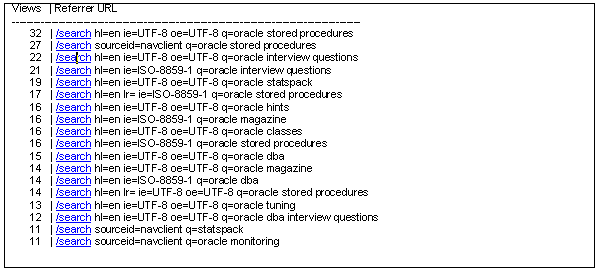
Listing 1: A referrer report of Google keywords.
By themselves, referrer statistics are critical to companies who rely on search engines to bring them traffic. On the Web site in listing 1, we see exactly the keywords that are used by new visitors to find the Web site, and the frequency of the keywords.
However, tracking and storing details about your visit is only half the story, and to be efficient, the Web site must have details about your demographics.
Learning More About You
Demographic collection is a critical part of a successful formula for personalization technology. Without demographics, we cannot develop multivariate correlations that compare your viewing and purchasing behavior with known groups of customers.
When you sign on to an eCommerce site for the first time, you will most likely provide enough personal information to uniquely identify yourself. The eCommerce server takes your identity information and collects demographics about you (refer to figure 1). These demographics include your sex, age, income level, credit history, and other publicly available information about your income, social status, and personal interests.
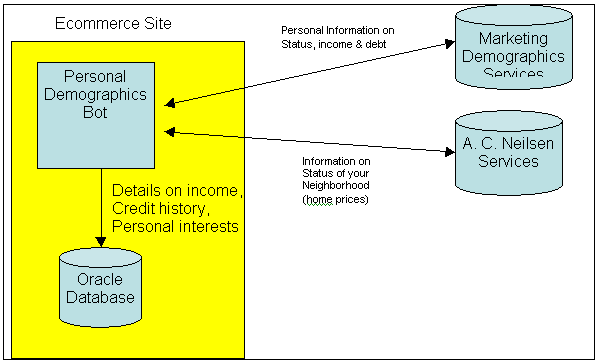
Figure 1: Demographics collection mechanism for eCommerce.
Once collected, this information is stored in a large Oracle database. Using this data, complex multivariate (Chi-square) analysis is performed, and detailed predictive models are created. These models are used to customize the Web content.
Gimme a Cookie
At this point, the Web site knows details about your browsing behavior, but we next must have a means to positively identify each visitor so we can spy on their browsing behavior. Web developers for eCommerce systems have faced the challenge by writing cookies into the PC of the customer. A cookie is a small flat-file that serves to positively identify each visitor.
As an interesting side-note, these files were called cookies after the famous Cookie Monster rogue software on the MIT student system. For more than a year, a hidden program named Cookie Monster would randomly interrupt user session and demand “Gimme Cookie.” When the student typed “cookie,” the software thanked them and restored their computing session.
As we have noted, we cannot use the IP address of the browser to verify the identity of a customer. Most ISPs use dynamic IP addressing where by the fourth octet of the IP is assigned at login time for example, an ISP may have the IP of 172.16.10.xxx, and xxx is a number assigned at ISP connect time. Without a static IP to identify the customer, eCommerce vendors must rely on cookies to get a positive ID on an incoming customer request.
You can easily see all of the cookies on your MS-Windows system (refer to figure 2).
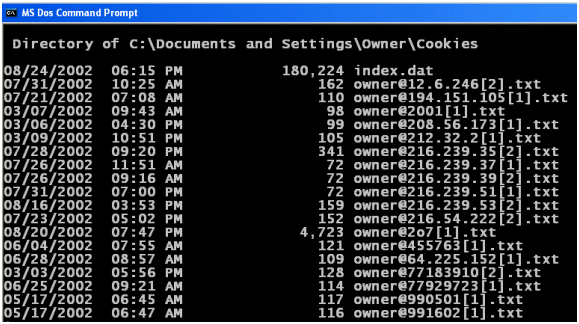
Figure 2: The location of your cookies directory on MS-Windows.
For fun, you can look inside your cookie file and get an idea about how cookies help the eCommerce site spy on your behavior. Here is an example of an Amazon cookie (refer to listing 2).
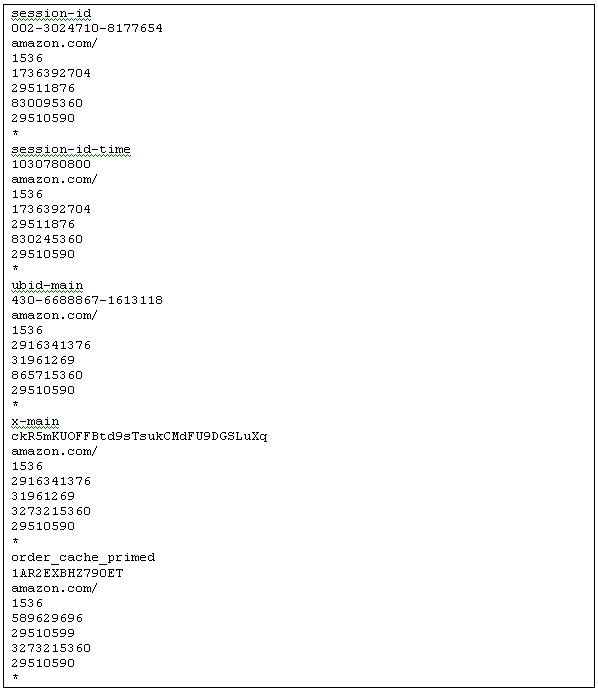
Listing 2: A sample cookie file.
Once you understand cookies, you can have fun with eCommerce sites either by removing the cookie or editing their contents. Next time you use such a site, take a minute to edit and change the cookie file before you go to the site.
Let’s see how cookies influence customized Web content. Below, we access Amazon.com without a Cookie file (refer to figure 3).
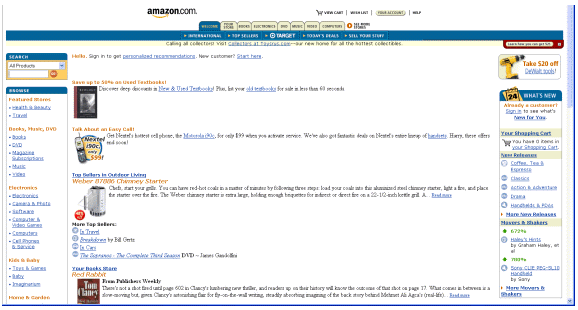
Figure 3: Amazon home page without a cookie.
Once we replace our cookie, we access Amazon and get a customized recommendation list (refer to figure 4). This list of recommendations is produced by a personalization engine that has carefully analyzed your viewing behavior, compared your behavior to other customers, correlated your demographics, and develops a customized predictive model of those items that you have the highest propensity to purchase.
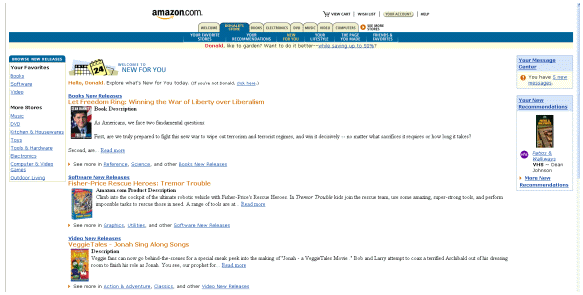
Figure 4: Accessing Amazon with a Cookie.
At this point, we should now have an understanding of how eCommerce sites collect information about you and your behavior. Next, let’s look at how they use the data to recommend purchases for visitors.
Oracle’s Solution to Personalization
Analyzing referrer data on a busy eCommerce site is a formidable computing challenge. Companies such as Oracle have developed tools such as the ORACLEiAS Personalization engine and Oracle Data Mining Suite (formerly the Darwin product) to assist with this complex process. The nature of this analysis is very resource intensive, and almost all large eCommerce sites must devote large servers exclusively for developing predictive recommendations.
With millions of dollars each year in impulse purchases at stake, IT marketing professionals know that it is critical of get the right products onto your custom page. To be successful, the system must be able to accurately predict your propensity to buy a product, based on two factors:
1. Prior buying and browsing patterns
2. Buying patterns of like-minded customers (customer profiling)
The challenge in developing these models is accurately placing visitors into consumer groups. A consumer group is a group of customers with similar demographics, and hence, similar buying patterns. Some shops tag these groups with “handles” such as yuppies, dinks (double income, no kids), and so on.
Figure 5 shows the process of analyzing demographic information to place visitors into consumer groups. A visitor can be placed into a consumer group in two ways:
1 - Their demographic category (collected from personal information)
2 - Their pattern of page views (collected from referrer URLs)
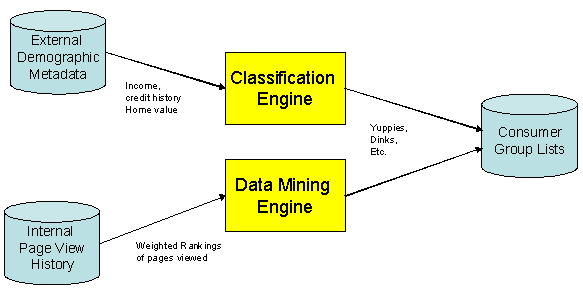
Figure 5: Categorizing users into consumer groups.
Once we have defined consumer groups, we next start a data mining procedure to correlate the patterns of each consumer group to specific products (refer to f6). The customized HTML personalization is based on data from three sources:
1. Known consumer group data — These are predetermined summaries of consumer group characteristics.
2. Weighted rankings of pages viewed — This is a measure of the popularity of product pages according to each consumer group.
3. Sales history data — This is historical sales data, correlated by consumer group.
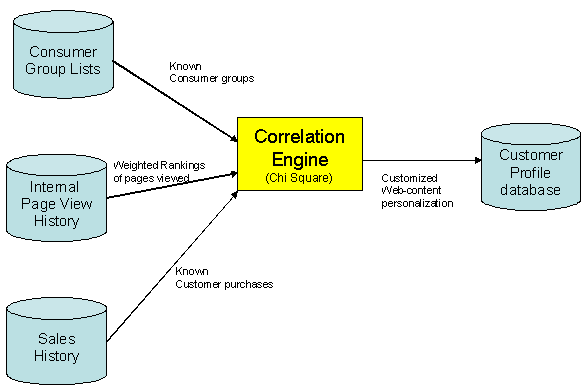
Figure 6: Correlating consumer groups to product preferences.
After we have the consumer groups ready, the Oracle database can quickly generate customized HTML (refer to figure 7). Here we see three steps:
1. Initial Request — The customer browser makes an HTTP request to the Web listener.
2. Get the Cookie — The Web server sends a request to the browser PC to get the cookie file
3. Deliver the custom page — The cookie file verifies the identity of the visitor, and customized HTML is created by the app server based on the identity, and the custom HTML is delivered back to the browser.
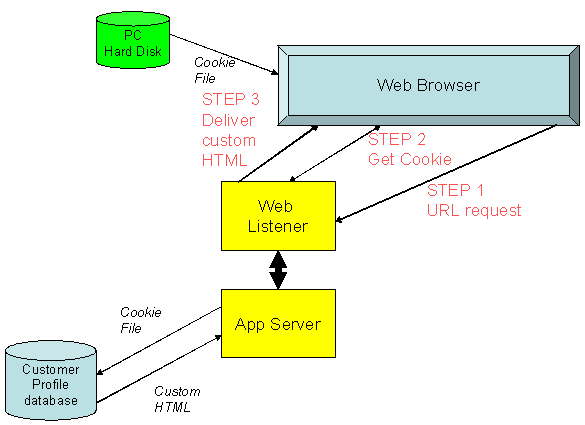
Figure 7: Delivering custom HTML pages.
Despite the inherent complexity of personalization technology, vendors are creating interfaces to the software. The Oracle product even offers a GUI interface to aid in the complex analysis of referrer statistics (refer to figure 8).
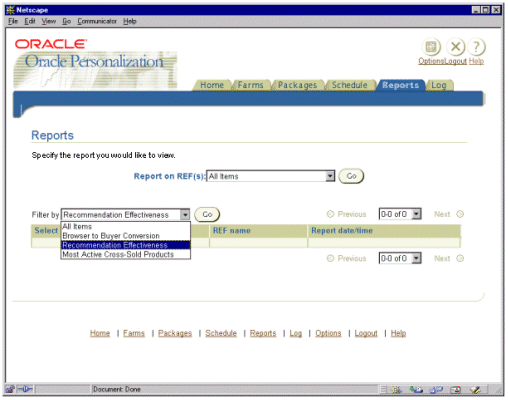
Figure 8: The Oracle iAS Personalization GUI.
These tools use sophisticated data mining technology to constantly peruse the database looking for statistically-significant correlations. Often, these predictions are obvious (i.e., long underwear does not sell well in Hawaii), but other predictions are amazing. Some predictive models have been able to accurately target new products to exactly the type of people who will want them. This is the classic “need creation” model used by successful companies like Sony. For example, Sony launched the first Walkman because they had empirical evidence that customers would look at the product and say “I need that,” even though the customer had no prior knowledge that they needed the product.
Conclusion
While the technology surrounding personalization of Web content is already extremely sophisticated, IT professionals are constantly making it even more complex. Artificial Intelligence routines are now being employed to develop detailed models about how consumers spend their disposable income.
Oracle Corporation is making headway into this market with their Data Mining Suite and Personalization Engine software. These products are sophisticated programs that interface with the Oracle database.
Along with threes advances will come even more concerns about the loss of privacy on the Internet, but for now, customers appear only too happy to provide the raw data needed to analyze their spending patterns.
--
Donald K. Burleson is one of the world’s top Oracle database experts. He has written 14 books, published more than 100 articles in national magazines, and serves as editor-in-chief of Oracle Internals, a leading Oracle database journal. As a leading corporate database consultant, Don has worked with numerous Fortune 500 corporations creating robust database architectures for mission-critical systems. Don’s Web sites are http://www.dba-oracle.com and http://www.remote-dba.net/.
Contributors : Donald K. Burleson
Last modified 2005-06-22 12:01 AM
